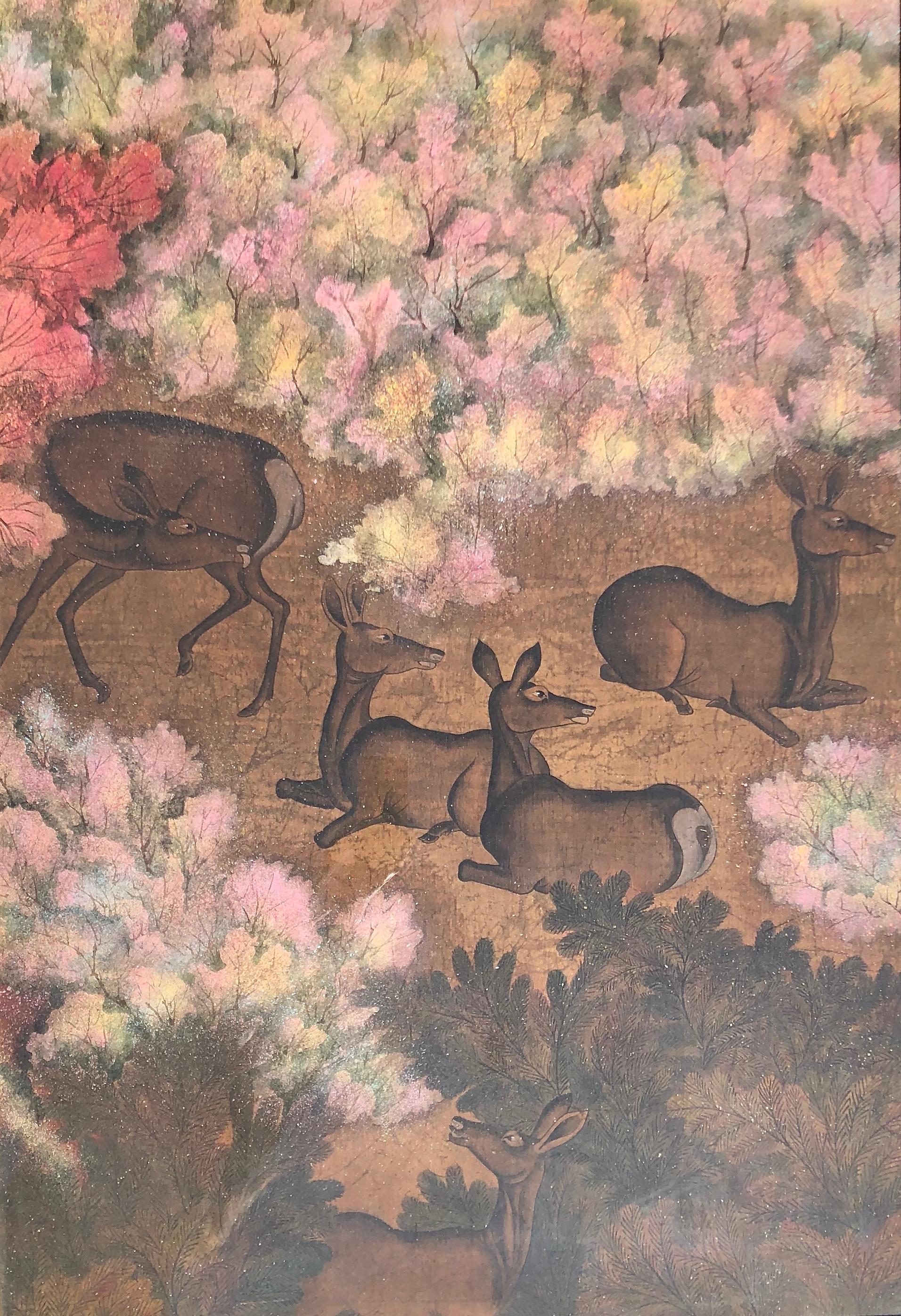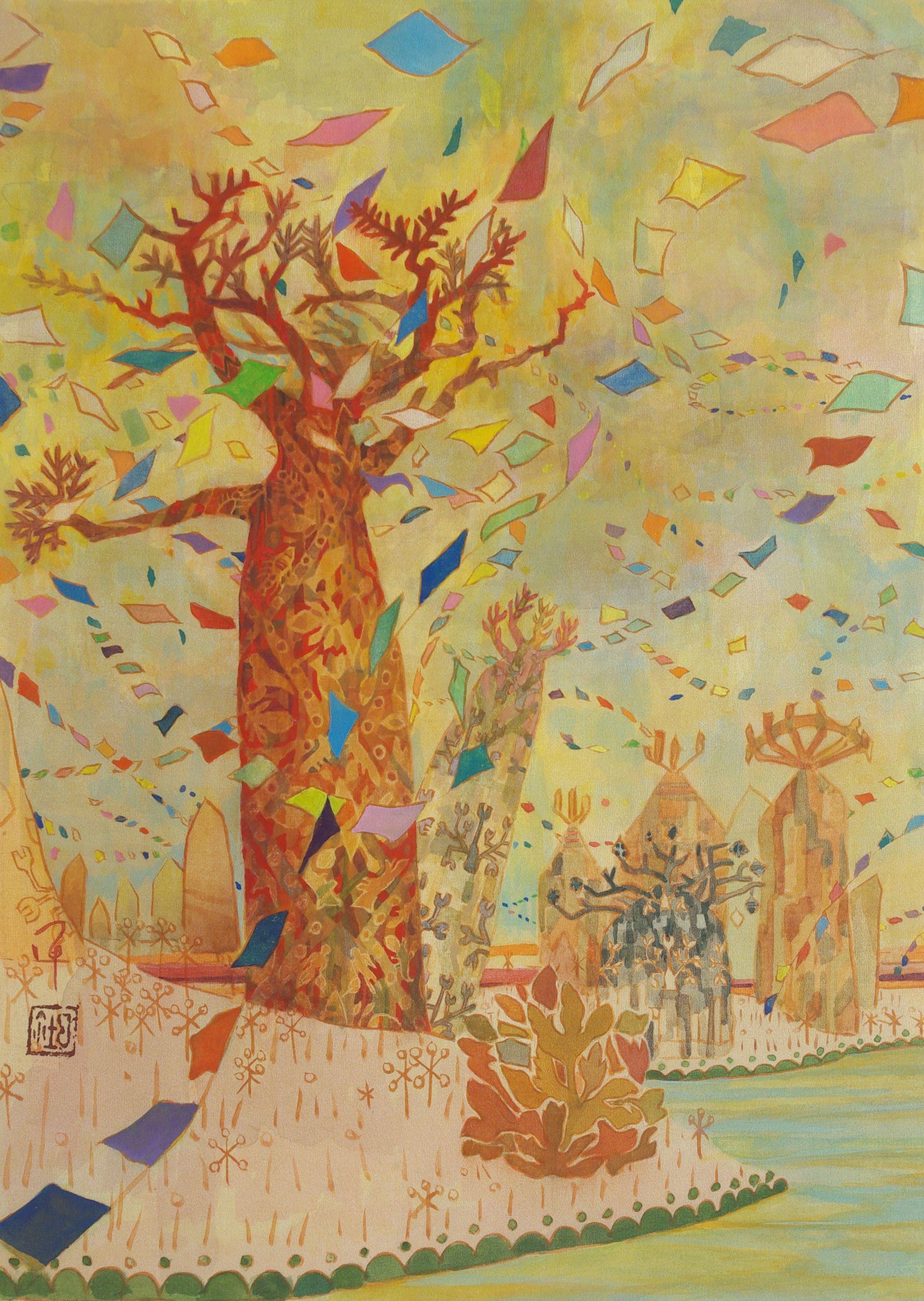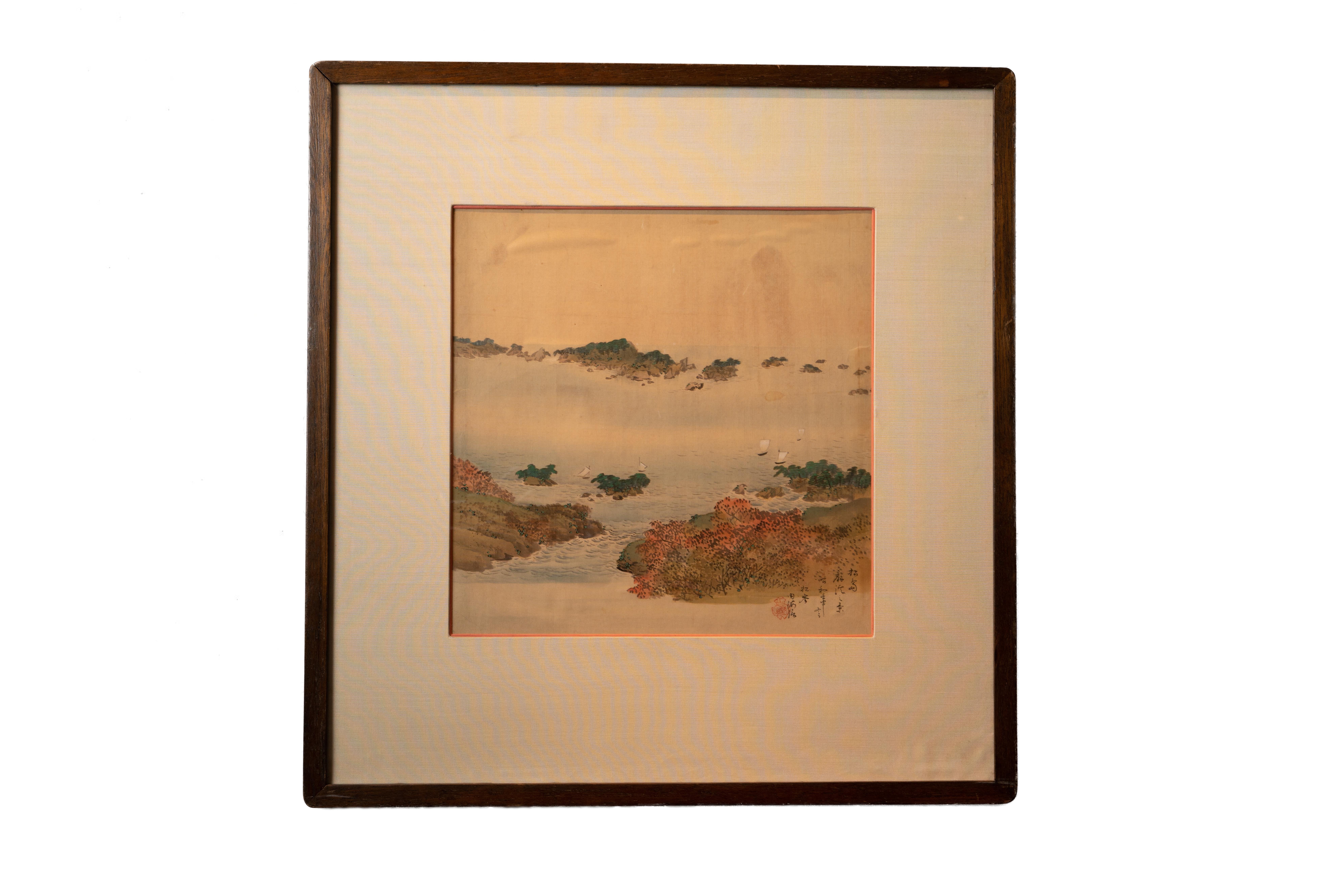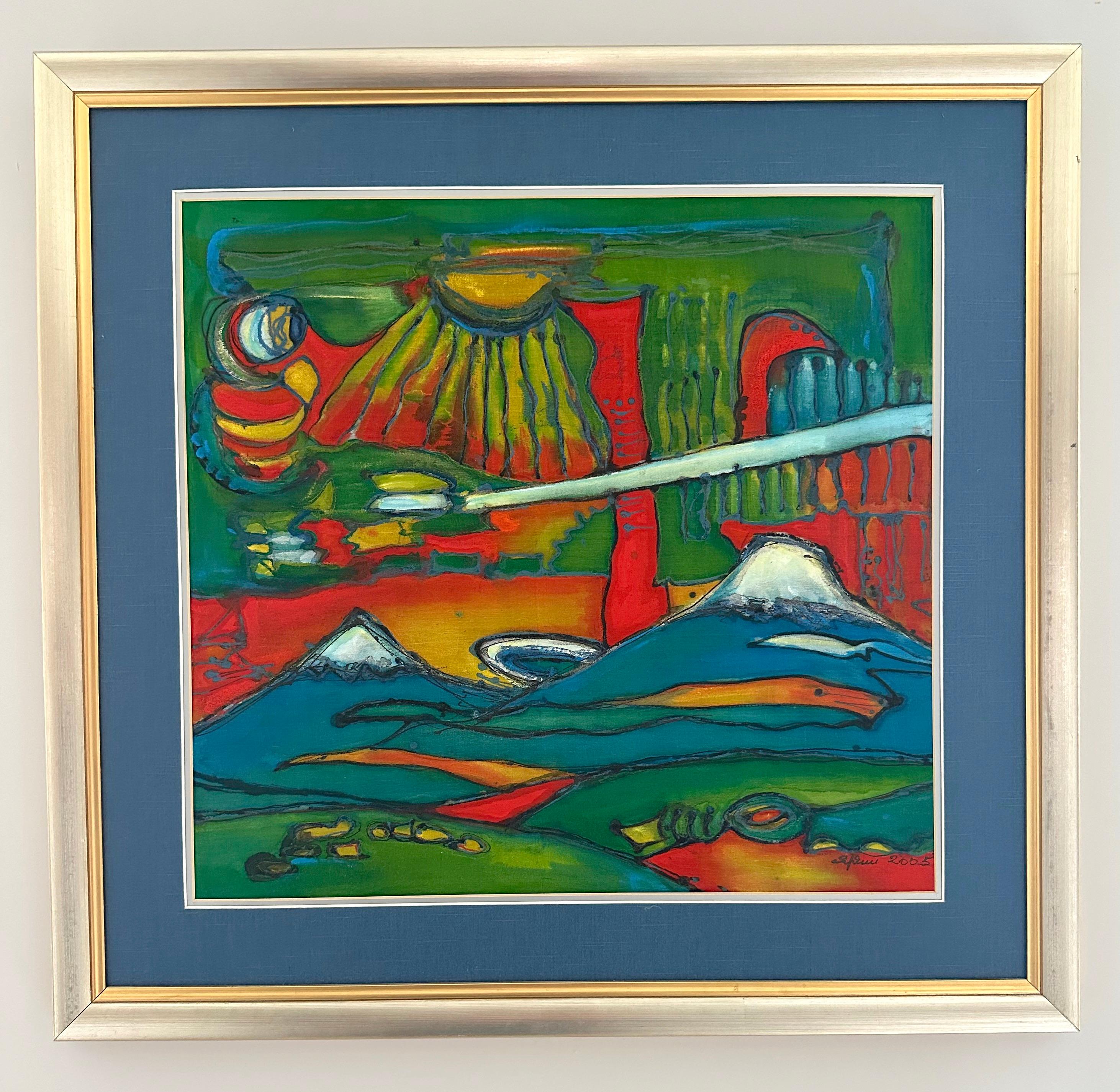Items Similar to Early Israeli Batik on Silk Painting Jerusalem Landscape with Figure Bezalel
Want more images or videos?
Request additional images or videos from the seller
Miriam HadgadyaEarly Israeli Batik on Silk Painting Jerusalem Landscape with Figure Bezalel
About the Item
Subject: Figure with water pitcher in jerusalem landscape
Medium: Mixed Media
Surface: Paper
Country: Israel
All but forgotten today, Had Gadya was the first woman to study at the Bezalel Art School and an outstanding painter in 1920s' Tel Aviv.
In 1912, she was 17 years old, the only female student at Bezalel. She had just come from Russia, and had been given the curious nickname "Had Gadya."
During her first year at Bezalel, the artist and teacher Shmuel Levy Ophel painted a wonderful portrait of Had Gadya, a girl-woman, in shades of dusky blue. Her expression was both innocent and arousing - her trademark.
In the 1920s, Had Gadya was the face of Bezalel. A kind of muse, a boyish nymph. She appears in a number of photographs by Yaakov Ben Dov, who documented life at Bezalel in the early years.
But Had Gadya was more than a pretty face. She was a talented painter, according to the chief curator of the Israel Museum, Yigal Zalmona.
In contrast, art historian Gideon Ofrat believes that her "spirit hovers over the complex and legendary beginnings of Bezalel and Boris Schatz and that is all."
Had Gadya's real name was Marousia (Miriam) Nissenholtz. She was born in Russia in 1895 in a small town called Kodama, near Odessa. Both her parents were pharmacists.
The most significant event in her life was without a doubt the Bezalel exhibition in Odessa. On Passover in 1911, Boris Schatz came to display works created at Bezalel and to enlist new students and funding for the institution, which was then barely surviving. It was still very cold when the big white tent went up in Alexander Park in the center of the city, according to sources of the period. Roman columns and a symbol of the Ten Commandments were placed at the front of the tent, and above the entrance a sign bore the word "Bezalel" in gilded letters. A "tapestry of the holy places" was unfurled, and nine crates containing the works of art were unloaded.
The excitement was great. Mendele Mocher Sforim was photographed with Schatz at the front of the tent. Later, inside, Schatz presented magic lantern pictures to an audience of hundreds. Marousia was also charmed.
There are conflicting versions as to how the name Had Gadya was born. Had Gadya (literally "an only kid" - the name of a popular seder song) was a common symbol at Bezalel, and the subject of illustrations by Zeev Raban. Nachum Gutman and others described their classmate as mischievous, skipping around like a goat on the mountains. In her autobiographical manuscript, Had Gadya says she invented the name for herself, as she felt like a young goat among wolves because the boys harassed her.
For some reason this venture did not last. Like other women painters - Ziona Tajar, and later Aviva Uri and Lea Nikel, who was a good friend of Had Gadya - Had Gadya decided to pursue her art abroad. In 1921 she decided to leave her daughter, then three, and travel to Europe. Not to the art capital of Paris, but to Vienna, where among other things she studied batik, which was to become a main source of her livelihood.
Ofrat argues that Tajar, who went to Paris as soon as she completed her studies, brought back Modernism, and any one who did not do the same was doomed to oblivion at that time. Zalmona adds that Tajar struggled to get where she was professionally, but also had the right connections with gallery owners and art critics, while Had Gadya had no one to depend on. "Schatz could no longer help her because the art scene and the power centers had moved to Tel Aviv," he says.
Carmela Rubin, director of the Reuven Rubin Museum in Tel Aviv, says that Had Gadya's story cannot be divorced from the issue of the status of women artists in those years. Rubin, the daughter-in-law of the famed painter, researched the history of other struggling women artists from that period, like Yonah Shechter Zaliuk and Mussia Bograshov.
"In the 1920s, these painters, who were good painters, exhibited in major shows at Haohel Theater. But the moment they got married, they became invisible," Rubin says. "This was not only because family life and the life of a woman artist could not be combined, but because no one paid attention to them. All of them, including Tajar, Lea Nikel and Aviva Uri, paid a heavy price for their career at a time when women were not expected to stand out. They were expected to stay home. They left their children and devoted themselves to art, but a little later than Had Gadya did."
In the 1950s, she got married for the third time, to a penniless illustrator of children's books. She left him a few years later and returned to Israel, first living in Ein Karem in Jerusalem, and then moving to the artists' quarter in Safed, where she became friends with artists Lea Nikel and Hava Levy. In her latter years, she lived with her elder daughter in Tel Aviv, Shulamit Abulafia Cifroni (who died this year).
In the 1970s, in Safed, Had Gadya began painting large abstracts, full of color and squares. In one, beyond the geometric patterns, as if behind a transparent curtain, a woman can be seen holding a baby, reminiscent of the Madonna and child. "She felt she was being liberated and reaching her destination as an artist," Joelson says.
- Creator:Miriam Hadgadya (1895 - 1982, Israeli)
- Dimensions:Height: 19 in (48.26 cm)Width: 15 in (38.1 cm)
- Medium:
- Movement & Style:
- Period:
- Condition:Condition consistent with age and history. Some minor discoloration. needs new frame and mat.
- Gallery Location:Surfside, FL
- Reference Number:1stDibs: LU38211980012
About the Seller
4.9
Platinum Seller
These expertly vetted sellers are 1stDibs' most experienced sellers and are rated highest by our customers.
Established in 1995
1stDibs seller since 2014
1,549 sales on 1stDibs
Typical response time: 1 hour
- ShippingRetrieving quote...Ships From: Surfside, FL
- Return PolicyA return for this item may be initiated within 3 days of delivery.
More From This SellerView All
- 1927 Oil Painting Eiffel Tower Paris American Modernist Wpa Artist Morris KantorBy Morris KantorLocated in Surfside, FLMorris Kantor New York (1896 - 1974) Paris from the Ile St. Louis, 1927 (view of Eiffel Tower) Oil painting on canvas Hand Signed lower left. Provenance: Hirshhorn Museum and Sculpture Garden, Smithsonian Institution ( bears label verso) Size: 20 3/4"H x 28 1/8"W (sight), 28.75 "H x 36"W (framed) Morris Kantor (Belarusian: Морыс Кантор) (1896-1974) was a Russian Empire-born American painter based in the New York City area. Born in Minsk on April 15, 1896, Kantor was brought to the United States in 1906 at age 10, in order to join his father who had previously relocated to the states. He made his home in West Nyack, New York for much of his life, and died there in 1974. He produced a prolific and diverse body of work, much of it in the form of paintings, which is distinguished by its stylistic variety over his long career. Perhaps his most widely recognized work is the iconic painting "Baseball At Night", which depicts an early night baseball game played under artificial electric light. Although he is best known for his paintings executed in a realistic manner, over the course of his life he also spent time working in styles such as Cubism and Futurism, and produced a number of abstract or non-figural works. A famous cubist, Futurist, painting of his "Orchestra" brought over 500,000$ at Christie's auction house in 2018 Kantor found employment in the Garment District upon his arrival in New York City, and was not able to begin formal art studies until 1916, when he began courses at the now-defunct Independent School of Art. He studied landscape painting with Homer Boss (1882-1956). In 1928, after returning to New York City from a year in Paris, Kantor developed a style in which he combined Realism with Fantasy, often taking the streets of New York as his subject matter. He did some moody Surrealist Nude paintings and fantasy scenes. In the 1940's he turned towards figural studies. Later in his career, Kantor himself was an instructor at the Cooper Union and also at the Art Students League of New York in the 1940s, and taught many pupils who later became famous artists in their own right, such as Knox Martin, Robert Rauschenberg, Sigmund Abeles and Susan Weil...Category
1920s American Modern Landscape Paintings
MaterialsCanvas, Oil
- Jerusalem Old City Cityscape Israeli Modernist Oil Painting Signed in HebrewLocated in Surfside, FLSigned Nathanson. Could be the famous artist Avraham Naton (Natanson) I am not certain. it is a very lovely Modernist Israeli landscape. Avraham Naton (Natanson), Israeli, born in Bessarabia, 1906-1959. Avraham Naton was born in Rani, Bessarabia to a large secular family. In 1935, after Art studies in Romania, he immigrated to the Land of Israel and settled, first, in Givat Haim and later in Ramat Gan. From the 1940s he worked as an Art teacher in Ramat Gan and Givataim. In 1948 he worked as an illustrator at BaMahane Newspaper. He was one of the Founders of New Horizon Group. Between 1952-1959 he was a member of the Milo Club and served as the club secretary. Education 1930-33 Art Academy, Bucharest, Romania Teaching 1940's Ramat Gan and Givataim Awards And Prizes Jerusalem Prize for Painting and Sculpture 1942 Dizengoff Prize 1953 Milo Club Prize New Horizons, The Ofakim Hadashim art movement began with a group of artists who mounted an exhibition in Tel Aviv's Habima national theater in December 1942, under the name "The Group of Eight". The group evolved into a coherent artistic movement only after the founding of the state of Israel in 1948. Members of the school included Arie Aroch, Zvi Meirovitch, Avraham Naton (Natanson), Avigdor Stematsky and Yehezkel Streichman. The work of sculptor Dov Feigin also appeared in the catalog of the 1942 exhibition, though it was not displayed. In February 1947 five of the original members of the group joined Joseph Zaritsky...Category
1950s Modern Landscape Paintings
MaterialsCanvas, Oil
- Large Abstract landscape of Jerusalem Israeli Oil Painting JudaicaBy Avraham BinderLocated in Surfside, FLAvraham Binder was born in 1906 in Vilnius (or Vilna), now part of Lithuania. He began painting at an early age and completed the prescribed studies in painting at the academy of art...Category
20th Century Modern Landscape Paintings
MaterialsOil, Canvas
- Austrian Magic Realist Oil Painting Vibrant Village Landscape Scene Franz CoufalLocated in Surfside, FLFramed 24.5 x 28.5 image 19.5 x 23 inches. Franz Anton Coufal (Austrian, 1927 - 1999) Painter and sculptor known for figure painting, bronze sculpture, genre paintings and as a graphic artist. After completing an apprenticeship as a locksmith, Franz Anton Coufal attended the Graphic Education and Research Institute in Vienna from 1947 to 1949 as a student of André Roder and from 1949 to 1953 took lessons from Ignaz Schönbrunner. From 1953 to 1959 he finally studied with Fritz Wotruba at the Academy of Fine Arts (diploma and master school award 1959). Coufal then went on study trips to Germany and Italy and then settled in Vienna as a sculptor and graphic artist. His work bears the influence of Austrian Magic Realism and the artists Friedensreich Hundertwasser, Arik Erich Brauer and Ernst Fuchs. THis work also has Expressionist elements to it. He organized exhibitions in Vienna (from 1955), Paris (1962, 1970) and Brussels (1964) as well as in other Austrian cities. His most important works include the honorary grave for Leopold Figl in the central cemetery (1966). In 1979 he provided the design for the face of the silver 100 schilling coin "Festival and Congress House Bregenz", in 1980 he created the Lehár monument for the city park, and in 1987 he received the special prize in the "Danube Region Vienna" competition. A select list of his sculptures in public spaces "Standing youth" (19, Hameaustraße - Celtesgasse, urban residential complex; 1960) "Reclining youth" (22, Kagran [Meißnergasse - Maißauer Gasse - Anton-Sattler-Gasse]; artificial stone, 1962) "Flammender Turm" (16, Thaliastraße 159; marble) Cubist marble sculpture (11, Molitorgasse at 15) Drinking fountain (20, Adalbert-Stifter-Straße primary school; 1968) Figldenkmal (1, Minoritenplatz, 1973) Coufal created some of his later works for the "Harmonie" rest home for the blind in Unterdambach near Neulengbach (memorial for the 144 blind people who perished in concentration camps, unveiled in 2000; stone sculpture "Monument to Humanity" on the terrace; rose-thorn cross and tabernacle for the in-house Odilien- Chapel; bronze portrait sculpture by Robert Vogel in the entrance hall, unveiled July 3, 1994). Bibliography Rudolf Schmidt: Austrian artist lexicon. From the beginning to the present. Vienna: Tusch 1974-1980 Who's Who in the world. Volume 2: 1974-1975. New Providence, NJ: Marquis Who's Who 1974 Who's who in the world. Volume 3: 1976-1977. New Providence, NJ: Marquis Who's Who 1976 Who is Who in Austria with South Tyrol part (Hübner's "Blue Who is Who"). Zug: Who is who, Verlag für Personalenzyklopädien 12 1995 Otto Breicha: Franz Anton Coufal In: Franz Anton Coufal. Österreichische Staatsdruckerei, December 9-22, 1964. Vienna: Staatsdruckerei 1964 The press, July 30, 1963 Of the generation of Viennese artists Alois Mosbacher, Josef Mikl, Oswald Oberhuber, Christian Ludwig Attersee, Peter Sengl, Max Weiler, Franz Ringel, Gunter Brus, Hubert Schmalix, Wilhelm Kaufmann, Paul Flora, Oscar Larsen, Hans Staudacher, Siegfried Anzinger, Ernst Huber...Category
20th Century Modern Landscape Paintings
MaterialsOil, Canvas
- Fishing Shack, School of Paris Barbizon Oil Painting Night Time Landscape, HorseBy Guy CambierLocated in Surfside, FLGuy Cambier Oil Painting (French, 1923-2008), "Cabane du Pêcheur", oil on panel, signed "Guy Cambier" at lower right, inscriptions verso, 23"h x 31.5"w (sight), 33.25"h x 41.75" with...Category
Mid-20th Century Modern Landscape Paintings
MaterialsCanvas, Oil
- King David, Jerusalem (after Marc Chagall) Oil Painting Israeli Judaica ArtBy Zammy SteynovitzLocated in Surfside, FLFramed 41.5 x 29.5 image 35.5 x 23.5 This large painting depicts a man and woman, Adam and Eve, interlocked and embracing one another. The woman holds an enticing apple as they are thrusted from the Garden of Eden. This is an original painting. Zamy Steynovitz was born in Liegnitz Poland, in 1951. He immigrated to Israel in 1957. The aspiration to be a painter stems from his childhood and before leaving Poland, he won the first prize in an art competition for children. Zamy was formally educated at the Art School in Tel-Aviv and at the Royal Academy of London. Upon completing his studies, Zamy earnestly pursued his career and establish his place in the art world by displaying his work in one man exhibits and arts fairs around the world. His art displays chromatic and thematic richness and his choice of subjects has been strongly influenced by Jewish tradition, his Eastern European Jewish heritage and folklore. Zamy’s popular themes include Paris cafes, still-life, flowers, circuses and landscapes. Circus with acrobats and Harlequin. In the early stages of his career, he was partial to rich pastels and light brush strokes. In the early 1980s, Zamy visited South America, where the new surroundings enhanced his work with local brightness and color. His art gained chromatic power and his palette became richer in tones as the textures became thicker and the background darker and more colorful. These changes coupled with his thematic persistence allowed him to develop into a sensitive and mature artist. Zamy expresses a universal humanistic vision in his creations: man’s connection to his heritage and physical surroundings, two imperative aspects of our lives that should be heralded during these estranged technological times. As a result of his devotion to world peace, Zamy is known in the circles of the Nobel Institute for Peace in Norway. He is acquainted with many Nobel Prize winners including Anwar Sadat, Menachem Begin, the Dalai Lama, Itzhak Rabin, Shimon Peres, Elie Wiesel, Desmond Tutu and Oscar Arias, the ex-President of Costa Rica, along with many other politicians and artists. Zamy tragically passed away in September 2000. Exhibitions One Man Show 1970 - Museum - Ramat - Gan 1973 - Brussels - Gallery L'Angle Aigu 1974 - London - International Gallery 1974 - Paris - Grand Palais Gallery 1975 - Milan - Brera Gallery 1976 - N.Y. Valentino Gallery - N.Y. Hilton 1977 - N.Y. Valentino Gallery - N.Y. Hilton 1978 - Basel - Actual Gallery 1978 - Geneve - Bohren Gallery 1978 - Oslo - Nobel Peace Prize Exhibit 1979 - London - Hamilton Gallery 1979 - N.Y. - Art Israel Kalt - Waldinger Gallery 1979 - N.Y. - Canty Art Gallery 1979 - Amsterdam - Schipper Gallery 1979 - Washington - International Art Fair 1980 - Cleveland -Jewish Museum 1980 - Tel-Aviv - Habima National Art Fair 1981 - Abraham - Goodman House N.Y. 1981 - San Lucas Galley - Bogota 1982 - Pedro Gerson Gallery - Mexico City 1983 - Simon Bolivar...Category
20th Century Modern Figurative Paintings
MaterialsCanvas, Oil
You May Also Like
- Reindeer In The ForestLocated in Lake Worth Beach, FLReindeer In Forest Tempera on silk, wonderful gold leaf frame under glass, by Chinese artist Ma Hai Feng born 1958.Category
1980s Modern Animal Paintings
MaterialsEgg Tempera, Silk
- "2000 Years Old" Japanese landscape painting pigments on silk nature baobab treeBy Maki KuchidaLocated in Kowloon, Hong Kong2000 Years Old is 2020 work of Maki Kuchida. It is a signature landscape work by Maki combining Japanese and Chinese landscape painting style. This works is a tribute to the mythical...Category
2010s Contemporary Landscape Paintings
MaterialsMixed Media, Pigment, Acrylic, Silk
- 'Chinese Mountain Scene, ' by Unknown, Watercolor on Silk PaintingLocated in Oklahoma City, OKThis framed 24" x 23" watercolor on silk by an Unknown Chinese artist depicts a coastal mountain landscape. This work features several mountain clus...Category
Late 19th Century Other Art Style Landscape Drawings and Watercolors
MaterialsSilk, Watercolor
- 'Wait for Me, ' by Diane Coady, Oil and Silk on Canvas PaintingBy Diane CoadyLocated in Oklahoma City, OKThis 24" x 36" oil and silk on canvas painting created in 2015 by artist Diane Coady, depicts an abstracted environment with boats and rabbits in a palette...Category
2010s Abstract Landscape Paintings
MaterialsCanvas, Silk, Oil
- Ararat, Batik, Abstract Landscape, Original Painting, Ready to Hang, FramedLocated in Granada Hills, CAArtist: Nina Aghavelyan Work: Original painting, handmade artwork, one of a kind Medium: Batic, Acrylic on Silk Year: 2005 Style: Contemporary art Title: Ararat, Size: 21" x 23" inc...Category
2010s Abstract Expressionist Landscape Paintings
MaterialsAcrylic, Silk
- 'Geese on a Lake', Chinese scroll, calligraphy, Sumi-e, Song, Yuan DynastyBy Ren RenfaLocated in Santa Cruz, CAChinese School, 20th century; After Ren Renfa (Qinglongzhen, 1255-1328). Signed center right in Chinese with artist chop mark for 'Yueshan Daoren' 月山道人, brush name for Ren Renfa. (Qinglongzhen [now Qingpu, Songjiang, Shanghai Municipality], b.1255; d. 1328). Chinese painter. Under the Yuan dynasty (1279–1368) he became an official, rising to the level of Vice-President of the River Conservation Bureau. He was famous for his paintings of horses, which were much admired by both his Mongol and Chinese patrons. In horse painting he followed in the tradition of the Song-period (960–1279) artist Li Gonglin, which was characterized by use of the ‘iron-wire’ line and a minimum of shading. Ultimately, however, Ren’s style can be traced to the Tang (ad 618–907) painters Yan Liben and Han Gan. Ren’s earliest surviving painting is dated 1280, indicating that he was a mature artist by his mid-twenties. Although he worked as an official under the alien Mongol emperors, he was capable of paintings that incorporated clear political messages. The most famous is Fat and Lean Horses (Beijing, Pal. Mus.), in which, according to his inscription, the fat horse...Category
Mid-20th Century Animal Paintings
MaterialsSilk, Sumi Ink, Watercolor, Plywood
Recently Viewed
View AllMore Ways To Browse
Art On Silk
Painted On Silk
Silk On Silk Painting
Painting On Silk
Stay Home
Large Europe Landscape Painting
Large European Landscape Painting
New Jerusalem
Silk City
Silk Pictures
The New Jerusalem
Russian Landscape Painters
Vintage Landscape Illustration
Israel Landscape
Vintage Felt Paintings
Real Silk
Watered Silk
Israel Landscape Painting




